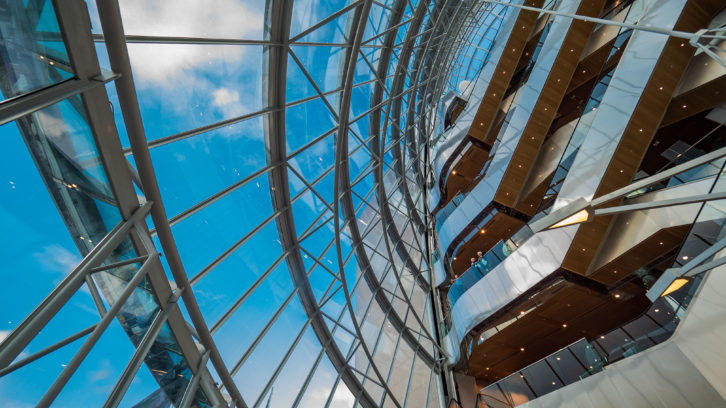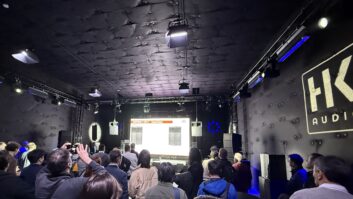
In the first part of this conference venues feature we revealed how centres are increasing technology spend and leveraging displays of all types to meet the increasing expectations of the clientele. Here Ian McMurray looks at the elements that providers need to consider to get the right device for the specific conference venue environment.
The fact is that many of the negatives for both projection and videowalls have been largely eliminated. Projection cost of ownership and ease of maintenance have been addressed by solid state illumination, although, as Fulton-Langley points out, that has brought its own problem.
“Yes, laser is becoming more popular and definitely ticks all the boxes in terms of quality and low maintenance,” he says, “but current pricing is prohibitive for some, especially for large-scale replacement of ageing projectors.”
As solid state becomes the default, however, that situation will certainly improve – much as ultra-short throw (UST) lenses have eliminated the casting of shadows on the screen.
Videowalls, meanwhile, with the growing capability of LED technology, are now bezel-less; have finer pixel pitches; are easier to calibrate; and are becoming increasingly affordable.
“Videowalls are definitely becoming more popular, but the cost of LED is still a barrier to entry for many”
Christian Czimny, Absen
Christian Czimny, European R&D director at Absen, is certainly aware that LED pricing has thus far proved dissuasive.
“Videowalls are definitely becoming more popular, but the cost of LED is still a barrier to entry for many,” he acknowledges. “Absen is committed to making the technology more accessible and affordable for the mass market by standardising on the technology. For example, we have released an all-in-one videowall solution that has been specifically designed to meet the requirements of conferencing centres. Called the Absenicon, this LED videowall comes in five sizes ranging from 110in to 220in and includes its own control system, wireless connectivity and wall mounts.”
Choosing what will be used to deliver images should, of course, be first and foremost a function of understanding the application – in some detail – as Graeff explains.
Many factors
“Choosing the right device is all about the environment it will be used in,” he says. “There are many factors to consider here. The key point is to map your rooms with the needs of the end user/audience in mind. To that end, the key questions to ask include: what is the size of the room? What is the purpose of the room? What will the audience do in this room? What will the speaker do? What type of meeting will be held here – is it presentation, briefing or is it for brainstorming? Will it be used for team building? By establishing its purpose, you’ll be better informed when it comes to deciding.”
The decision about how best to deliver images may also depend on other factors – such as competitive advantage.
“Projectors remain more affordable and flexible for different size spaces. Further, they are increasingly low maintenance,” confirms Sony’s Standertskjold. “Videowalls are more complex to set up and maintain, but have higher brightness and contrast. Further, videowalls will act as a differentiator for conference centres given their relative scarcity in the market and the big visual impact they deliver.”
That point is reinforced by Visavvi’s Etchells. “We’re seeing a more pronounced interest at university level in LED lecture theatre screens,” he says. “They are seen as cutting edge and something different to projection. It is most likely that they will continue to be more popular as the price decreases further.”
For many conference centres, it seems that – for now at least – projection remains the popular option. Choosing the right projector is, of course, key – but it can, as Fulton-Langley points out, be all too easy to overlook something important.
Heresy
“The projection surface is extremely important, although it can often be seen as a minor consideration,” he explains. “For front projection, high gain screens offer a brighter image in increased ambient light, but the trade-off is hot spots in the middle of the screen, and a poorer viewing angle. Low gain screens, conversely, offer a larger field of view, but are more suited to areas where ambient light can be controlled, such as cinemas and auditoriums. Rear projection is a good option, and can provide an image with no shadowing, and in an environment where ambient light is easier to control. There must however be enough throw distance behind the screen.”
Nothing to disagree with there. His next point, however, would certainly be viewed as heretical by the screen manufacturers of the world.
“Having said all this, if a wall is painted with a good quality projection paint, and has been plastered to a high standard, a plain wall can offer a surprisingly good surface at a minimal cost, and in some circumstances, is desirable where UST projectors are utilised, as these can highlight irregularities in a screen’s profile, and manifest in images with a high degree of curvature.”
One of the key reasons for the popularity of projection appears to be the flexibility projectors offer – and flexibility is of paramount importance to those who operate the facility, a point made previously by Standertskjold.
www.absen.com
www.cdec.co.uk
www.panasonic.com
www.pureav.co.uk
www.pro.sony
www.unilumin.com
www.visavvi.com
www.vivitek.eu







